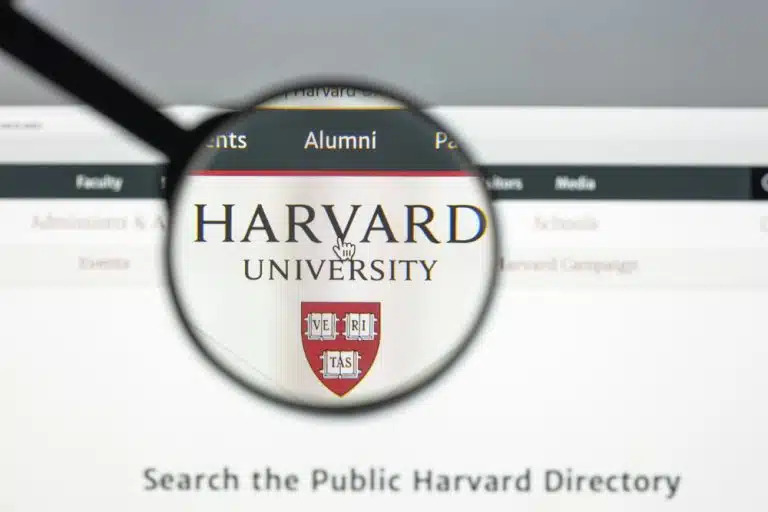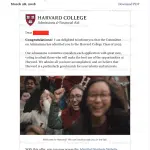You’ve submitted your Harvard application—now comes the waiting game. Like thousands of other applicants, you’re probably refreshing your inbox or checking your Applicant Portal daily. Knowing exactly when Harvard decisions come out can help you plan the months ahead.
In this blog, we’ll break down everything you need to know about Harvard’s decision release schedule. You’ll find timelines for Restrictive Early Action, Regular Decision, waitlist notifications, and transfer applicants. We’ll also share the latest acceptance rate data and offer tips on what to do once you receive your decision.
- When Does Harvard Release Decisions?
- When Do Harvard Early Decisions Come Out?
- When Do Harvard Regular Decisions Come Out?
- When Do Harvard Waitlist Decisions Come Out?
- When Do Harvard Transfer Decisions Come Out?
- What to Do After Receiving Your Harvard Admissions Decision
- Frequently Asked Questions
- Takeaways
When Does Harvard Release Decisions?
Harvard offers several application routes, each with its own timeline and set of outcomes. If you applied through Restrictive Early Action (REA), you’ll hear back much earlier than those who chose Regular Decision (RD). There’s also a separate process for transfer applicants and those placed on the waitlist.
Here’s a quick table showing the typical notification dates for each application route at Harvard:
| Application Route | Decision Release Date (Notification Date) | Decision Types |
| Restrictive Early Action | Mid-December | Admit, Defer, Deny |
| Regular Decision | End of March | Admit, Waitlist, Deny |
For the Class of 2029, Harvard has confirmed the specific release dates:
- Restrictive Early Action decisions were released on December 12, 2024.
- Regular Decision results came out on March 27, 2025, which also marked Ivy Day.
When Do Harvard Early Decisions Come Out?
If you applied through Harvard’s Restrictive Early Action (REA) plan, your wait is shorter than most. You’ll typically receive your Harvard REA decision in mid-December. Here’s a detailed look at the REA schedule:
| Date | Event |
| August 1 | Application Start |
| November 1 | Restrictive Early Action Deadline |
| Mid-December | Restrictive Early Action Decision Notification |
| Early May | Reply Deadline |
All materials, including your essays and recommendation letters, are due by November 1. A holistic review of applications begins right after the deadline. Harvard REA decisions come out mid-December, often between the 13th and 15th. If you’re admitted, you must respond by early May, typically May 1.
What is Harvard Early Action?
Harvard’s Restrictive Early Action plan allows you to apply early without committing right away. It’s non-binding, meaning even if you’re accepted, you’re not required to enroll.
The “restrictive” part refers to where else you’re allowed to apply early. If you choose Harvard REA, you can’t apply early to any other private college, whether their early plan is binding or not. However, you can still apply early to:
- Public universities (non-binding)
- Foreign institutions (non-binding)
- U.S. military academies
- Regular Decision or Early Decision II programs at any school
- Scholarship or academic programs that require early applications, as long as they are non-binding
REA is designed for students who see Harvard as a top choice but still want to keep their options open until the May 1 decision deadline.
Harvard Early Action results
Restrictive Early Action applicants at Harvard can receive one of three outcomes:
- Admit. You’re in! While you’re accepted early, you don’t have to respond until May 1.
- Defer. Your application is moved to the Regular Decision pool for further review. You’ll receive a final decision in late March.
- Deny. Your application is closed for this cycle. Unfortunately, you can’t reapply until the following year.
These decisions usually come out through the Harvard Applicant Portal in mid-December. Harvard will send you an email letting you know your decision is ready, but you’ll need to log in to the portal to see the actual result.
Harvard Early Action acceptance rate
Harvard’s early round is more selective than it might seem at first glance. For the Class of 2028, 7,921 students applied through REA, and 688 were admitted, resulting in an 8.7% acceptance rate.
That number may look generous compared to Regular Decision, which had an acceptance rate of just 2.7%. But keep in mind: the early pool tends to attract highly competitive applicants. These are students who’ve done their homework, taken rigorous courses, and written strong, thoughtful essays.
Compared to the overall acceptance rate of 3.6%, REA does offer a slightly better shot. But it’s still Harvard. The odds are tough.
When Do Harvard Regular Decisions Come Out?
For most applicants, Harvard’s Regular Decision (RD) path is the default. It gives you the most time to prepare your application, but it also comes with tougher competition. You’ll typically receive your Harvard RD result in late March, often around the end of the month. Here’s a detailed look at the timeline for Harvard’s RD process:
| Date | Event |
| August 1 | Application Start |
| January 1 | Regular Decision Deadline |
| End of March | Regular Decision Notification |
| Early May | Reply Deadline |
Your application is due by January 1. The RD review process runs from January through March, with a holistic evaluation beginning shortly after the deadline. Harvard RD decisions typically come out at the end of March. If you’re admitted, you’ll need to respond by early May, typically May 1, which is the National College Decision Day.
What is Harvard Regular Decision?
Regular Decision is Harvard’s standard application route. It’s non-binding, meaning you’re under no obligation to attend if admitted. Go for RD if you:
- Want more time to prepare your application
- Are applying to multiple colleges and want to compare offers
- Don’t feel ready for the early round
- Aren’t eligible for Restrictive Early Action due to restrictions
Unlike REA, RD lets you apply to as many schools as you’d like, including those with Early Decision II plans. The flexibility is greater, but keep in mind: the acceptance rate is usually lower, due to increased competition and fewer remaining spots in the class.
Harvard Regular Decision results
In the Regular Decision round, you can receive one of three outcomes:
- Admit. You’re offered admission and have until May 1 to make your decision.
- Waitlist. You haven’t been admitted yet, but you may be offered a spot later in the spring or summer.
- Deny. Your application is closed for this admissions cycle.
Decisions typically come out in late March, often on a Thursday or Friday, via the Harvard Applicant Portal. While Harvard will send an email letting you know your decision is ready, you’ll need to log in to the portal to view the result.
Harvard Regular Decision acceptance rate
The numbers tell a clear story. For the Class of 2028, Harvard received 46,087 Regular Decision applications. Of those, just 1,245 students were admitted, resulting in a 2.7% acceptance rate for the RD round.
Compare that to the 8.7% acceptance rate for Restrictive Early Action, and it’s clear that a significant portion of the class is filled early. The overall acceptance rate, combining both REA and RD, was 3.6%.
This sharp drop during RD is common across highly selective schools. By the time March rolls around, Harvard has already secured a substantial part of its incoming class from early applicants—leaving fewer spots for a much larger pool of RD candidates.
When Do Harvard Waitlist Decisions Come Out?
Getting waitlisted by Harvard means you’re clearly a qualified applicant, but there wasn’t enough space in the initial round to offer you a spot. It’s not a rejection—but it’s also not a guarantee. You’re placed in a kind of holding pattern: still in the running, but only if space becomes available later in the process.
Harvard waitlist decisions are released on a rolling basis from early May to late July. Here’s how the waitlist timeline typically unfolds:
| Date | Event |
| Late March to Early April | Waitlist Placement |
| April to Early May | Waitlist Confirmation |
| Early May to Late July | Release of Waitlist Decisions |
If you’re placed on the Harvard waitlist, it usually happens in late March or early April, just after Regular Decision results come out. To stay in consideration, you’ll need to confirm your spot on the waitlist—usually by early May.
The waitlist review period runs from early May through July, while Harvard closely monitors how many admitted students accept their offers. If space opens up, the admissions office may begin extending rolling offers to select waitlisted applicants.
If you do receive an offer, be ready to move quickly—you’ll typically need to respond within a few days to secure your place in the incoming class.
Importantly, Harvard does not rank its waitlist. Instead, decisions are made based on institutional needs—things like academic interests, geographic diversity, or other priorities. In some years, Harvard admits no one off the waitlist. In other years, 200+ students receive offers. That variability makes it hard to predict your chances.
Because of this uncertainty, it’s important to have a solid backup plan—a school you’re excited about and ready to commit to, just in case the waitlist doesn’t work out.
When Do Harvard Transfer Decisions Come Out?
Transfer applicants at Harvard follow a different admissions cycle than first-year students. While Harvard releases first-year decisions in December and March, transfer decisions typically come out by mid-June. That means if you apply by the March 1 deadline, you’ll likely wait over three months before hearing back.
Here’s a detailed timeline:
| Date | Event |
| January | Application Start |
| March 1 | Transfer Application Deadline |
| Mid-June | Transfer Application Notification |
Harvard’s transfer application becomes available in January. You must submit your completed application and all required financial aid materials by the March 1 deadline. After that, applications are reviewed from March through May.
You can expect to receive a decision by June 15 via the applicant portal, though some applicants may hear back earlier. If you’re admitted, you’re expected to enroll in the fall and respond to your offer shortly after receiving it.
Unlike first-year admissions, Harvard does not admit transfer students for the spring semester and does not allow deferrals. Although submitting early doesn’t increase your chances of admission, it gives you more time to track your materials and ensure your transcripts reflect your latest academic performance.
Harvard’s transfer process is extremely competitive. For the Class of 2027, for example, there were 1,892 transfer applicants—but only 15 were accepted, resulting in an acceptance rate of just 0.8%.
The admissions committee looks for students with a strong academic reason to transfer, an excellent college transcript, and compelling faculty recommendations. To be eligible, you must have completed at least one continuous academic year at your current institution—but no more than two—by the time you would enroll at Harvard.
Given the low acceptance rate and lack of deferral options, it’s wise to keep your options open and continue planning for other schools while waiting on Harvard’s transfer decision.
What to Do After Receiving Your Harvard Admissions Decision
Once your decision is in, you’ll need to move quickly—but thoughtfully. Whether you’re accepted, deferred, waitlisted, or denied, there are clear next steps to take, and how you respond can shape your path forward.
If you’re accepted
First, take a moment to celebrate. Congratulations! Then log in to the Harvard Applicant Portal to formally accept your offer. Be sure to confirm your enrollment by May 1, so don’t miss that deadline.
Next, carefully review your financial aid package. Harvard meets 100% of demonstrated financial need, so if anything seems unclear, reach out to the financial aid office for clarification. You may also need to submit additional documents to finalize your aid.
Start preparing for the transition. This includes planning for housing, travel, medical requirements, and any pre-orientation programs. It’s also a great time to connect with your future classmates through admitted student events or online communities.
If you’re deferred
A deferral isn’t a rejection. It means Harvard will reconsider your application during the Regular Decision round.
If you’re still serious about attending, consider sending a letter of continued interest. Keep it concise and meaningful: reaffirm your enthusiasm, share any significant updates or achievements, and avoid restating what’s already in your application.
Avoid overwhelming the admissions office with additional materials unless they specifically request them. Meanwhile, focus on maintaining strong academics, staying engaged in your current activities, and preparing for outcomes from other schools.
If you’re waitlisted
If you’re still interested in attending Harvard, log into your portal to accept your spot on the waitlist. Then consider sending a brief, thoughtful note to express your continued interest and update the admissions office on any recent academic or personal developments.
That said, don’t just wait. Be sure to secure a place at another college by May 1 and submit your deposit. If you’re later admitted off the waitlist, you can always make the switch—just know you’ll likely forfeit that deposit.
In the meantime, keep your grades up and stay engaged. A strong finish to the semester could make a difference.
If you’re denied
Rejection is never easy, especially from a school as selective as Harvard. But it’s important to remember that a denial is not a reflection of your worth or potential. Give yourself time to process the news, and then begin looking ahead.
There are countless outstanding colleges that will recognize and value what you bring. Revisit your options, compare financial aid offers, and think about where you’ll thrive—both academically and personally. Many students find that a “no” from one school ultimately led them to a better fit—and often, to opportunities they never expected.
Frequently Asked Questions
1. What time of day do Harvard decisions usually come out?
Admissions decisions are generally released in the evening, around 7:00 PM Eastern Time (ET). For example, Regular Decision results for the Class of 2029 were announced no earlier than 7 PM ET on Thursday, March 27, 2025.
2. When does Harvard release Early Action decisions?
Harvard’s Restrictive Early Action decisions are typically released in mid-December. For the Class of 2029, REA decisions were released on December 12, 2024. The exact date can vary each year, but notifications are usually available in the Applicant Portal around 7:00 PM ET on the designated day
3. When does Harvard release Regular Decision results?
Harvard Regular Decision results are typically released in late March, often on Ivy Day (the day when all Ivy League schools announce their admissions decisions). For the Class of 2029, decisions were released on March 27, 2025, at 7:00 PM ET.
4. Can I appeal if Harvard rejects my application?
Harvard doesn’t have a formal appeals process for undergraduate admissions decisions. Once a decision has been made, it is considered final. If you remain interested in attending Harvard, you may reapply in the future—either as a first-year applicant in the next cycle or as a transfer student after completing at least one full-time year at another college.
5. How does Harvard notify applicants of acceptance?
Harvard notifies applicants of their admissions decisions through the Applicant Portal. On the release date, you can log in to view your decision letter. Additionally, admitted students may receive further communications from the admissions office with information about next steps.
Takeaways
If you’ve been wondering when Harvard decisions come out, here are five key takeaways to help you stay on track:
- Harvard Regular Decision results are typically released during the last week of March, often coinciding with Ivy Day.
- Restrictive Early Action decisions usually come out in mid-December, between December 13 and 15.
- Waitlist offers begin in early May and can continue into July, depending on space in the incoming class.
- Transfer decisions are released by June 15, following the March 1 application deadline.
- Working with a college admissions consultant can help you craft a stronger Harvard application and improve your overall chances of admission.













































